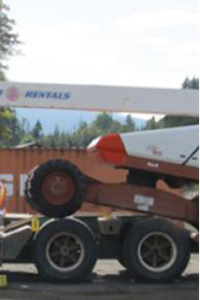Worker suffered fatal injuries after falling off lift
Date of incident: September 2013
Notice of incident number: 2013120030167
Employer: Construction company
Incident summary
A worker was attempting to offload a self-propelled elevating work platform (lift) from the rear of a low-bed trailer. The actual incident was not witnessed. To move the lift, the worker was using the controls in the work platform. While unloading the lift, the worker got out of the work platform and fell when the lift slid off the trailer. After the incident, someone who had arrived to buy livestock from the worker found him on the ground next to the low-bed trailer. The worker succumbed to his injuries in the hospital.
Investigation conclusions
Cause
- Unstable lift slid off low-bed trailer, resulting in fatal injuries: The investigation into this incident determined that the worker fell while walking down the boom of the lift to get off the lift. Once he fell, the lift's drive tire slid over his head, causing severe injuries. The worker later succumbed to the injuries.
Underlying factors
- Uncontrolled motion of lift: In order to move the lift onto the trailer's suspension rails, the worker put the lift into high speed to overcome the resistance of the lift's frame scraping on the suspension rails. This high speed resulted in lack of control over the lift, causing it to get stuck in a precarious position on the trailer.
- Weight shift resulted in equipment instability: The worker chose to exit the lift's work platform by walking down the lift's boom. As the worker walked along the boom from the work platform towards the body of the lift, his shifting weight caused the stuck lift to become unstable and slide off the trailer.
- Fall from elevation into hazardous area: The worker fell off the lift's boom and went head first into the pinch point of the lift's right drive tire and the trailer's left rear tires.
- Safer low-bedding practices not used: The trailer had a detachable gooseneck hitch at the front. The worker also had available a tractor that could have been used to remove the detachable hitch. With the hitch removed, the lift could have been safely driven off the front of the trailer.
- Method of unloading lift not acceptable: It is reasonable to assume that the worker intended to offload the lift from the back of the trailer, using the boom as a lever, as he had successfully done before. But this method is contrary to the manufacturer's safe work procedures. According to the manufacturer's operating manual, the work platform is designed to support personnel, their tools, and materials. The rated work load is 500 pounds. The manufacturer's operating manual also states, "Do not use boom for any other purpose than to position personnel, their tools, and materials." And it adds, "Do not use the TB60 [lift] as a crane, hoist, or jack."
According to a WorkSafeBC engineer, using the boom as a lever, as described above, to lift up one end of the machine, would place more than the rated load on the end of the boom. This would cause mechanical stress to the boom and the hydraulic systems. As a result of being used in this way, the boom and hydraulic systems would require a mechanical inspection and re-certification for safe use by a professional engineer.
The Canadian Standards Association standard B354.4-02 (Self-propelled Boom-supported Elevating Work Platforms) at section 5.3.4.2 states: "[A] structural inspection shall be performed after any actual, suspected, or potential damage is sustained during an incident that could potentially affect the structural integrity or stability of the aerial platform. Such incidents may include electrical contact, shock loads, fall arrest, collision, or cases of overstressing or stability failure."
2021-04-22 20:42:33

